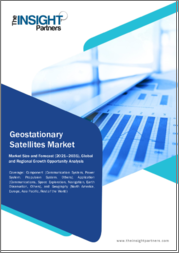
|
시장보고서
상품코드
1715221
아시아태평양의 정지궤도 위성 시장 예측(-2031년) : 지역별 분석 - 컴포넌트별, 용도별Asia Pacific Geostationary Satellites Market Forecast to 2031 - Regional Analysis - by Component and Application |
||||||
아시아태평양의 정지궤도 위성 시장은 2023년에 9억 6,608만 달러로 평가되었습니다. 2031년에는 13억 8,687만 달러에 달할 것으로 예상되며, 2023-2031년 4.6%의 연평균 복합 성장률(CAGR)을 보일 것으로 예측됩니다.
소형 정지궤도 위성의 개발로 아시아태평양의 정지궤도 위성 시장 성장 견인할 것
Maxar Space Systems, Astranis, Terran Orbital, SWISSto12, Saturn Satellite Network 등의 위성 제조업체들은 이미 정지궤도에 투입 가능한 소형 위성 개발에 집중하고 있습니다. 이를 통해 위성 운영사 및 발사 업체는 크기, 무게, 제조비용을 줄인 위성을 GEO 궤도에 투입하기 위한 운영비용을 절감할 수 있어 더욱 안심할 수 있으며, SATELLITE 2020 기간 동안 여러 위성 업체들이 소형 위성 전용 로켓으로 발사되는 정지궤도용 소형 위성인 소형 위성 전용 로켓으로 발사되는 정지궤도용 소형 위성 개발에 집중하고 있다고 발표했습니다. 정지궤도 배치를 위한 소형 위성 개발은 향후 몇 년 동안 시장 공급업체들에게 새로운 기회를 제공할 가능성이 높습니다.
아시아태평양의 정지궤도 위성 시장 개요
아시아태평양의 정지궤도 위성 시장의 성장은 위성 기반 내비게이션, 통신 및 일부 원격 감지 용도를 개선하기 위한 수요 증가에 기인합니다. 중국, 인도, 호주, 일본은 위성 발사에 많은 노력을 기울이고 있습니다. 아시아태평양의 정지궤도 위성 시장의 주요 기업으로는 Neumann, Beijing Spacecraft Manufacturing Co., Ltd, China Aerospace Science Technology Corporation, Kongtian Dongli 등이 있습니다. 2024년 3월, Thaicom Satellite Telecommunications는 Astranis에 소형 정지궤도 위성 Thaicom-9를 주문하여 2025년에 정지궤도에 투입할 계획이며, Astranis 와 Space Tech Innovation Limited(Thaicom의 자회사)와의 계약의 일환으로, Thaicom은 Astranis의 MicroGEO 위성을 배치하여 아시아에 Ka 밴드 서비스를 제공할 예정입니다. 이 새로운 위성은 또한 아시아의 가장 외딴 지역과 연결되지 않은 지역에 광대역 연결을 제공할 수 있습니다.
아시아태평양의 정지궤도 위성 시장 수익 및 2031년까지의 예측(금액)
아시아태평양의 정지궤도 위성 시장 세분화
아시아태평양의 정지궤도 위성 시장은 구성 요소, 용도 및 국가별로 분류됩니다.
구성 요소에 따라 아시아태평양의 정지궤도 위성 시장은 통신 시스템, 전력 시스템, 추진 시스템, 기타로 분류됩니다. 통신 시스템 부문이 2023년 가장 높은 시장 점유율을 차지했습니다.
용도별로 아시아태평양의 정지궤도 위성 시장은 통신, 우주탐사, 항법, 지구관측, 기타로 분류되며, 2023년에는 통신 분야가 가장 큰 시장 점유율을 차지할 것으로 예측됩니다.
국가별로 아시아태평양의 정지궤도 위성 시장은 중국, 인도, 일본, 한국, 기타 아시아태평양으로 구분되며, 2023년 아시아태평양의 정지궤도 위성 시장 점유율은 중국이 독차지했습니다.
Airbus SE,Ball Corp,Israel Aerospace Industries Ltd,Korea Aerospace Industries Ltd,Lockheed Martin Corp,Northrop Grumman Corp,Thales SA,The Boeing Co는 아시아태평양의 정지궤도 위성 시장에서 사업을 전개하는 주요 기업입니다.
목차
제1장 서론
제2장 주요 요약
- 주요 인사이트
- 시장의 매력
제3장 조사 방법
- 2차 조사
- 1차 조사
- 가설 책정
- 거시경제 요인 분석
- 파운데이션 수치 개발
- 데이터 삼각측량
- 국가 레벨 데이터
제4장 아시아태평양의 정지궤도 위성 시장 구도
- Porter의 Five Forces 분석
- 생태계 분석
- 위성 컴포넌트 제조업체
- 정지궤도 위성 제조업체
- 최종사용자
- 정지궤도 위성 시스템 프로바이더 리스트
제5장 아시아태평양의 정지궤도 위성 시장 : 주요 시장 역학
- 아시아태평양의 정지궤도 위성 시장 : 주요 시장 역학
- 시장 성장 촉진요인
- 시장 성장 억제요인
- 시장 기회
- 향후 동향
- 성장 촉진요인과 억제요인의 영향
제6장 정지궤도 위성 시장 : 아시아태평양 시장 분석
- 아시아태평양 개요
- 정지궤도 위성 시장 매출, 2021년-2031년
- 정지궤도 위성 시장 예측 분석
제7장 아시아태평양의 정지궤도 위성 시장 분석 - 컴포넌트별
- 통신 시스템
- 전력 시스템
- 추진 시스템
- 기타
제8장 아시아태평양의 정지궤도 위성 시장 분석 - 용도별
- 통신
- 우주 탐사
- 내비게이션
- 지구관측
- 기타
제9장 아시아태평양의 정지궤도 위성 시장 : 국가별 분석
- 아시아태평양 개요
- 아시아태평양
- 중국
- 인도
- 일본
- 한국
- 기타 아시아태평양
제10장 경쟁 구도
- 기업 포지셔닝과 집중도
제11장 업계 상황
- 시장 이니셔티브
- 제품 개발
제12장 기업 개요
- Airbus SE
- The Boeing Co
- Ball Corp
- Korea Aerospace Industries Ltd.
- Lockheed Martin Corp
- Northrop Grumman Corp
- Thales SA
- Israel Aerospace Industries Ltd
제13장 부록
LSH 25.05.20The Asia Pacific geostationary satellites market was valued at US$ 966.08 million in 2023 and is anticipated to reach US$ 1,386.87 million by 2031; it is estimated to register a CAGR of 4.6% from 2023 to 2031.
Development of Small Satellites for Geostationary Orbit Boosts Asia Pacific Geostationary Satellites Market
Satellite manufacturers such as Maxar Space Systems, Astranis, Terran Orbital, SWISSto12, and Saturn Satellite Network have already been focusing on the development of small satellites that can be deployed into the GEO orbit. This will further provide relief to the satellite operators and launch companies, reducing their operational costs for placing a satellite into the GEO orbit with lesser size, weight, and cost of manufacturing. During the conference of" SATELLITE 2020," several satellite companies announced that they have been focusing on the development of smallsat constellations for geostationary orbits that can be deployed through small satellite-specialized launch vehicles, which will ultimately reduce the overall cost of satellite launches and orbit placement of satellites into the GEO orbits. The development of small satellites for deployment into geostationary orbit is likely to generate new opportunities for market vendors in the coming years.
Asia Pacific Geostationary Satellites Market Overview
The Asia Pacific geostationary satellite market growth is attributed to the increasing need for improving satellite-based navigation, communication, and several remote sensing applications. China, India, Australia and Japan have a strong focus on the launch of satellites. Key players in the geostationary satellite market in Asia Pacific include Neumann; Beijing Spacecraft Manufacturing Co., Ltd; China Aerospace Science Technology Corporation; and Kongtian Dongli. These companies are renowned for their initiatives to contribute to the progress of space technology. In March 2024, Thaicom Satellite Telecommunications ordered a small geostationary satellite from Astranis-Thaicom-9-which is scheduled for launch in geostationary orbit in 2025. As part of the agreement between Astranis and Space Tech Innovation Limited (Thaicom's subsidiary), Thaicom would deploy the Astranis MicroGEO satellite to provide Ka-band services over Asia. The new satellite is also likely to provide broadband connectivity in the most remote and unconnected areas in Asia.
Asia Pacific Geostationary Satellites Market Revenue and Forecast to 2031 (US$ Million)
Asia Pacific Geostationary Satellites Market Segmentation
The Asia Pacific geostationary satellites market is categorized into component, application, and country.
Based on component, the Asia Pacific geostationary satellites market is segmented into communication system, power system, propulsion system, and others. The communication system segment held the largest market share in 2023.
In terms of application, the Asia Pacific geostationary satellites market is categorized into communications, space exploration, navigation, earth observation, and others. The communications segment held the largest market share in 2023.
By country, the Asia Pacific geostationary satellites market is segmented into China, India, Japan, South Korea, and the Rest of Asia Pacific. China dominated the Asia Pacific geostationary satellites market share in 2023.
Airbus SE, Ball Corp, Israel Aerospace Industries Ltd, Korea Aerospace Industries Ltd., Lockheed Martin Corp, Northrop Grumman Corp, Thales SA, and The Boeing Co are some of the leading companies operating in the Asia Pacific geostationary satellites market.
Table Of Contents
1. Introduction
- 1.1 The Insight Partners Research Report Guidance
- 1.2 Market Segmentation
2. Executive Summary
- 2.1 Key Insights
- 2.2 Market Attractiveness
3. Research Methodology
- 3.1 Secondary Research
- 3.2 Primary Research
- 3.2.1 Hypothesis formulation:
- 3.2.2 Macro-economic factor analysis:
- 3.2.3 Developing base number:
- 3.2.4 Data Triangulation:
- 3.2.5 Country level data:
4. Asia Pacific Geostationary Satellites Market Landscape
- 4.1 Overview
- 4.2 Porter's Five Forces Analysis
- 4.3 Ecosystem Analysis
- 4.3.1 Satellite Component Manufacturers:
- 4.3.2 Geostationary Satellite Manufacturers:
- 4.3.3 End Users:
- 4.3.4 List of Geostationary Satellite System Providers
5. Asia Pacific Geostationary Satellites Market - Key Market Dynamics
- 5.1 Asia Pacific Geostationary Satellites Market - Key Market Dynamics
- 5.2 Market Drivers
- 5.2.1 Increasing Demand for Long-Range Communication Coverage Through Satellite Network
- 5.2.2 Growing Need for Satellite-Based Military Communications
- 5.3 Market Restraints
- 5.3.1 Incidents of Geostationary Satellite Failures and Decline in Orders of Geostationary Satellites
- 5.4 Market Opportunities
- 5.4.1 Development of Small Satellites for Geostationary Orbit
- 5.5 Future Trends
- 5.5.1 Deployment of Software-Defined Electric Systems
- 5.6 Impact of Drivers and Restraints:
6. Geostationary Satellites Market - Asia Pacific Market Analysis
- 6.1 Asia Pacific Overview
- 6.2 Geostationary Satellites Market Revenue (US$ Million), 2021-2031
- 6.3 Geostationary Satellites Market Forecast Analysis
7. Asia Pacific Geostationary Satellites Market Analysis - by Component
- 7.1 Communication System
- 7.1.1 Overview
- 7.1.2 Communication System: Geostationary Satellites Market - Revenue and Forecast to 2031 (US$ Million)
- 7.2 Power System
- 7.2.1 Overview
- 7.2.2 Power System: Geostationary Satellites Market - Revenue and Forecast to 2031 (US$ Million)
- 7.3 Propulsion System
- 7.3.1 Overview
- 7.3.2 Propulsion System: Geostationary Satellites Market - Revenue and Forecast to 2031 (US$ Million)
- 7.4 Others
- 7.4.1 Overview
- 7.4.2 Others: Geostationary Satellites Market - Revenue and Forecast to 2031 (US$ Million)
8. Asia Pacific Geostationary Satellites Market Analysis - by Application
- 8.1 Communications
- 8.1.1 Overview
- 8.1.2 Communications: Geostationary Satellites Market - Revenue and Forecast to 2031 (US$ Million)
- 8.2 Space Exploration
- 8.2.1 Overview
- 8.2.2 Space Exploration: Geostationary Satellites Market - Revenue and Forecast to 2031 (US$ Million)
- 8.3 Navigation
- 8.3.1 Overview
- 8.3.2 Navigation: Geostationary Satellites Market - Revenue and Forecast to 2031 (US$ Million)
- 8.4 Earth Observation
- 8.4.1 Overview
- 8.4.2 Earth Observation: Geostationary Satellites Market - Revenue and Forecast to 2031 (US$ Million)
- 8.5 Others
- 8.5.1 Overview
- 8.5.2 Others: Geostationary Satellites Market - Revenue and Forecast to 2031 (US$ Million)
9. Asia Pacific Geostationary Satellites Market - Country Analysis
- 9.1 Overview Asia Pacific
- 9.1.1 Asia Pacific Geostationary Satellites Market, by Key Countries - Revenue (2023) (US$ Million)
- 9.1.2 Asia Pacific Geostationary Satellites Market - Revenue and Forecast Analysis - by Country
- 9.1.2.1 Asia Pacific: Geostationary Satellites Market - Revenue and Forecast Analysis - by Country
- 9.1.2.2 China: Geostationary Satellites Market - Revenue and Forecast to 2031 (US$ Million)
- 9.1.2.2.1 China: Geostationary Satellites Market Breakdown, by Component
- 9.1.2.2.2 China: Geostationary Satellites Market Breakdown, by Application
- 9.1.2.3 India: Geostationary Satellites Market - Revenue and Forecast to 2031 (US$ Million)
- 9.1.2.3.1 India: Geostationary Satellites Market Breakdown, by Component
- 9.1.2.3.2 India: Geostationary Satellites Market Breakdown, by Application
- 9.1.2.4 Japan: Geostationary Satellites Market - Revenue and Forecast to 2031 (US$ Million)
- 9.1.2.4.1 Japan: Geostationary Satellites Market Breakdown, by Component
- 9.1.2.4.2 Japan: Geostationary Satellites Market Breakdown, by Application
- 9.1.2.5 South Korea: Geostationary Satellites Market - Revenue and Forecast to 2031 (US$ Million)
- 9.1.2.5.1 South Korea: Geostationary Satellites Market Breakdown, by Component
- 9.1.2.5.2 South Korea: Geostationary Satellites Market Breakdown, by Application
- 9.1.2.6 Rest of Asia Pacific: Geostationary Satellites Market - Revenue and Forecast to 2031 (US$ Million)
- 9.1.2.6.1 Rest of Asia Pacific: Geostationary Satellites Market Breakdown, by Component
- 9.1.2.6.2 Rest of Asia Pacific: Geostationary Satellites Market Breakdown, by Application
10. Competitive Landscape
- 10.1 Company Positioning & Concentration
11. Industry Landscape
- 11.1 Overview
- 11.2 Market Initiative
- 11.3 Product Development
12. Company Profiles
- 12.1 Airbus SE
- 12.1.1 Key Facts
- 12.1.2 Business Description
- 12.1.3 Products and Services
- 12.1.4 Financial Overview
- 12.1.5 SWOT Analysis
- 12.1.6 Key Developments
- 12.2 The Boeing Co
- 12.2.1 Key Facts
- 12.2.2 Business Description
- 12.2.3 Products and Services
- 12.2.4 Financial Overview
- 12.2.5 SWOT Analysis
- 12.2.6 Key Developments
- 12.3 Ball Corp
- 12.3.1 Key Facts
- 12.3.2 Business Description
- 12.3.3 Products and Services
- 12.3.4 Financial Overview
- 12.3.5 SWOT Analysis
- 12.3.6 Key Developments
- 12.4 Korea Aerospace Industries Ltd.
- 12.4.1 Key Facts
- 12.4.2 Business Description
- 12.4.3 Products and Services
- 12.4.4 Financial Overview
- 12.4.5 SWOT Analysis
- 12.4.6 Key Developments
- 12.5 Lockheed Martin Corp
- 12.5.1 Key Facts
- 12.5.2 Business Description
- 12.5.3 Products and Services
- 12.5.4 Financial Overview
- 12.5.5 SWOT Analysis
- 12.5.6 Key Developments
- 12.6 Northrop Grumman Corp
- 12.6.1 Key Facts
- 12.6.2 Business Description
- 12.6.3 Products and Services
- 12.6.4 Financial Overview
- 12.6.5 SWOT Analysis
- 12.6.6 Key Developments
- 12.7 Thales SA
- 12.7.1 Key Facts
- 12.7.2 Business Description
- 12.7.3 Products and Services
- 12.7.4 Financial Overview
- 12.7.5 SWOT Analysis
- 12.7.6 Key Developments
- 12.8 Israel Aerospace Industries Ltd
- 12.8.1 Key Facts
- 12.8.2 Business Description
- 12.8.3 Products and Services
- 12.8.4 Financial Overview
- 12.8.5 SWOT Analysis
- 12.8.6 Key Developments
13. Appendix
- 13.1 About The Insight Partners



















